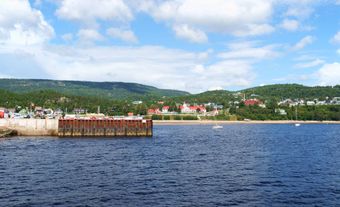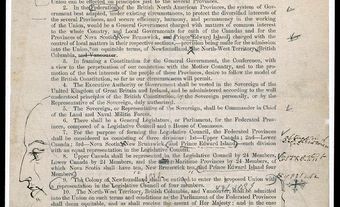Québec became one of the founding members of the Dominion of Canada on 1 July 1867 when it joined New Brunswick, Nova Scotia and Ontario in Confederation .
Province of Canada
Québec’s entry into Confederation is deeply tied to that of Ontario's. Together, the two were united into the Province of Canada in 1840, in response to the rebellions in Lower and Upper Canada, and the Durham Report of 1839.
The Act of Union established a single colony made up of Canada East (Québec) and Canada West (Ontario) governed by a single legislature. The British government, and English-speaking elites in both Canada East and West, hoped that the large French Canadian community would be submerged, and assimilated, within a single colony.
However, the common political system and the tensions it created between the French and English communities — along with a collection of sharply divided political parties in each region — created years of political deadlock that made the united colony difficult to govern. By the 1860s, leaders in both regions were pressing for change.
Case for Confederation
By 1858, George-Étienne Cartier, co-prime minister of the Province of Canada (along with Canada West's John A. Macdonald), favoured splitting up the two Canadas into separate provinces, and joining each one in a federal union with the other British North American colonies (New Brunswick, Nova Scotia, Prince Edward Island and Newfoundland and Labrador). Cartier and pro-Confederation forces in Canada East focused on four arguments:
- Political deadlock had made the Province of Canada almost impossible to govern. Proponents believed Confederation would allow a new federal government to make national decisions, while letting individual provinces find local solutions. As a self-governing province, Québec could safeguard French Canadian interests.
- Confederation would strengthen the wider economy.
- Britain had supported the losing South in the American Civil War , and some Canadians feared the victorious North would attack Canada in revenge. They believed creating a new country would blunt the desire for revenge.
- A federal government would be able to build a transcontinental railroad that would boost the economy and tie the colonies together.
Additionally, Canada’s Reciprocity Agreement with the United States expired in 1866, meaning Québec would soon lose access to that market. Supporters of Confederation argued that a merger with the other British North America colonies would provide better access to their markets.
Cartier and another Conservative, Alexander Tilloch Galt, agreed that Canada’s government would study the idea of a federal union of British North America. In 1864, Cartier represented Canada East at the Charlottetown Conference, where Confederation was agreed to. He also attended the Québec Conference, where the details of the new country were ironed out.
Confederation Foes
Jean-Baptiste-Éric Dorion led French Canadian resistance to Confederation. He founded the newspaper L’Avenir, and used it as a pulpit from which to attack Confederation.
“I oppose Confederation because I foresee innumerable difficulties with the joint powers given to the local and general governments in several areas. These conflicts will always be resolved in favour of the general government and to the detriment of the often legitimate claims of the provinces,” he wrote.
Antoine-Aimé Dorion, the Liberal leader in Canada East, opposed Confederation on the grounds that including the Maritime colonies would increase the financial burden on the Province of Canada, and that it could jeopardize the independence of each province. He wanted citizens with the franchise to vote on the issue.
Pro-Confederation forces led by Cartier, Galt and Hector-Louis Langevin won the support of the Catholic Church, and some of the public, by arguing that Confederation (and the division of the two Canadas into separate provinces) would give French Canadians back their provincial identity and a provincial capital.
Dominion of Canada Emerges
The British Parliament passed the British North America Act in March 1867. Canada East left the Province of Canada and joined the Dominion of Canada on 1 July 1867. The change drew little public reaction inside Québec, and newspapers merely reported on the few events organized to mark the day.
Québec's “Fathers of Confederation” are the men who attended one or more of the conferences at Charlottetown, Québec City and London. The list includes Sir George-Étienne Cartier, Jean-Charles Chapais, Sir Alexander Tilloch Galt, Sir Hector-Louis Langevin, Thomas D’Arcy McGee and Sir Étienne-Paschal Taché.

 Share on Facebook
Share on Facebook Share on X
Share on X Share by Email
Share by Email Share on Google Classroom
Share on Google Classroom






,_2016_(30216916871).jpg)


